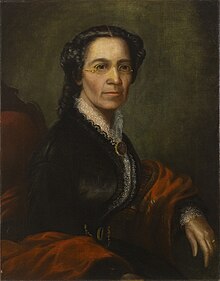Mary Jane Richardson Jones
| |||||||||||||||||
Read other articles:

Pierre Bergé Información personalNombre de nacimiento Pierre Vital Georges Bergé Nacimiento 14 de noviembre de 1930 Saint-Pierre-d'Oléron (Francia) Fallecimiento 8 de septiembre de 2017 (86 años)Saint-Rémy-de-Provence (Francia) Causa de muerte Enfermedad Nacionalidad FrancesaFamiliaCónyuge Yves Saint LaurentMadison Cox (2017) Pareja Yves Saint LaurentYves Saint Laurent Información profesionalOcupación Empresario, escritor, industrial, coleccionista de arte y mecenas Cargos ocupa...

If YouLagu oleh Big Bangdari album D / MADEDirilis1 Juli 2015 (2015-07-01)FormatUnduhan digitalGenrePop, BaladaDurasi4:24LabelYG EntertainmentPenciptaG-DragonProduserG-Dragon, P.K, Dee.P If You adalah singel dari boy band asal Korea Selatan, Big Bang. Singel ini dirilis secara digital pada 1 Juli 2015 oleh YG Entertainment sebagai singel pertama dari seri D sekaligus singel kelima dari rangkaian album MADE. Latar belakang Poster pertama beserta info judul lagu dan tanggal perilisan album...

This article is about one of several different Cape Government Railways locomotive types to be designated 6th Class. For the others, see Cape Government Railways 6th Class locomotives. CGR 6th Class 4-6-0 1897South African Class 6B 4-6-0CGR 6th Class no. 206, SAR Class 6B no. 494, c. 1930Type and origin♠ Original locomotive, as built♥ Locomotive equipped with Belpaire fireboxPower typeSteamDesignerCape Government Railways(H.M. Beatty)BuilderDübs and CompanyNeilson and CompanyNeilson, Rei...

يفتقر محتوى هذه المقالة إلى الاستشهاد بمصادر. فضلاً، ساهم في تطوير هذه المقالة من خلال إضافة مصادر موثوق بها. أي معلومات غير موثقة يمكن التشكيك بها وإزالتها. (ديسمبر 2019) الإدارة العسكرية (ألمانيا النازية) الدولة ألمانيا النازية تعديل مصدري - تعديل خلال الحرب العالمية...

Ini adalah nama Melayu; nama Abdul Rahman merupakan patronimik, bukan nama keluarga, dan tokoh ini dipanggil menggunakan nama depannya, Ahmad Razif. Ahmad Razif Abdul Rahman Ahmad Razif bin Abdul Rahman (lahir 7 November 1965) adalah Menteri Besar (Ketua Menteri) negara bagian Terengganu ke-14 dari 2014 sampai Mei 2018. Ia adalah anggota United Malays National Organisation dalam koalisi pemerintahan Malaysia Barisan Nasional.[1] Referensi ^ Terengganu MB Announces Exco Portfolios. Ber...

For other uses, see Settler (disambiguation). Nybyggarna redirects here. For the film, see The New Land. The Settlers First editionAuthorVilhelm MobergOriginal title'Nybyggarna'TranslatorGustaf LannestockCover artistNisse Zetterberg[1]CountrySwedenLanguageSwedishSeriesThe EmigrantsGenreHistorical novelPublisherBonniers (Swedish)Publication date1956Published in English1961Media typePrintPages535 pp (Swedish edition)ISBN0-87351-321-5OCLC32391776Dewey Decimal839.73/72...

هذه المقالة يتيمة إذ تصل إليها مقالات أخرى قليلة جدًا. فضلًا، ساعد بإضافة وصلة إليها في مقالات متعلقة بها. (أكتوبر 2022) انتفاضة كاتيب سومات الإسلامية معلومات عامة التاريخ 1833 - أوائل 1834 الموقع حول فان رانج، مقاطعة ننه توان، والمرتفعات الوسطى، جنوب فيتنام النتيجة الانتفاضة قم�...

List of events ← 1999 1998 1997 2000 in Federal Republic of Yugoslavia → 2001 2002 2003 Decades: See also:Other events of 2000 The following lists events that happened during 2000 in the Federal Republic of Yugoslavia. Incumbents President: Slobodan Milošević (until October 7), Vojislav Koštunica (starting October 7) Prime Minister: Momir Bulatović (until November 4), Zoran Žižić (starting November 4) Events January January 15 – Assassination of Željko Ražnatović, Serb...

Former theatre in Manhattan, New York Windsor Theatre redirects here. For other uses, see Windsor Theatre (disambiguation). 48th Street TheatreEquity 48th Street Theatre (1922–25)Windsor Theatre (1937–43)48th Street Theatre in 1912Address157 West 48th StreetManhattan, New York CityUnited StatesCoordinates40°45′35″N 73°59′00″W / 40.7597°N 73.9833°W / 40.7597; -73.9833TypeBroadwayConstructionOpenedAugust 12, 1912ClosedAugust 23, 1955Demolished1955Architec...

Este artículo o sección necesita referencias que aparezcan en una publicación acreditada.Este aviso fue puesto el 13 de mayo de 2018. Normal mapping usado para detallar una malla poligonal. El mapeado normal es la aplicación de una técnica 3D que permite dar una iluminación y relieve mucho más detallado a la superficie de un objeto. Es una evolución del mapeado topológico (bump mapping) y se aplica en videojuegos, principalmente en detalles pequeños como arrugas o poros, así como e...

كأس قبرص 2014–15 تفاصيل الموسم كأس قبرص النسخة 73 البلد قبرص التاريخ بداية:29 أكتوبر 2014 نهاية:20 مايو 2015 المنظم اتحاد قبرص لكرة القدم البطل نادي أبويل عدد المشاركين 26 الموقع الرسمي الموقع الرسمي كأس قبرص 2013–14 كأس قبرص 2015–16 تعديل مصدري - تعديل...

1935 film Tracy RidesDirected byHarry S. WebbWritten byNorman Hughes Betty BurbridgeRose GordonProduced byBernard B. Ray Harry S. WebbStarringTom TylerVirginia Brown FaireEdmund CobbCinematographyJ. Henry KruseEdited byFred BainProductioncompanyReliable PicturesDistributed byReliable PicturesRelease dateFebruary 26, 1935Running time60 minutesCountryUnited StatesLanguageEnglish Tracy Rides is a 1935 American Western film directed by Harry S. Webb and starring Tom Tyler, Virginia Brown Faire an...

艦歴 計画 ④計画 起工 1941年10月31日 進水 1942年7月4日 就役 1942年11月30日竣工 その後 1945年1月14日戦没 除籍 1945年3月1日 性能諸元 排水量 基準:720トン、公試:750トン 全長 74.70m 全幅 7.85m 吃水 2.60m 機関 マン式三号ディーゼル2基2軸 3,600馬力 速力 20.0kt 航続距離 14ktで2,000浬 燃料 重油:35トン 乗員 67名 兵装 8cm高角砲1基13mm連装機銃1基2挺爆雷36個、捕獲網8組(もしくは九三�...

Küre Hilfe zu Wappen Küre (Türkei) Basisdaten Provinz (il): Kastamonu Landkreis (ilçe): Küre Koordinaten: 41° 48′ N, 33° 43′ O41.80446833.7098971142Koordinaten: 41° 48′ 16″ N, 33° 42′ 36″ O Höhe: 1142 m Einwohner: 2.614[1] (2020) Telefonvorwahl: (+90) 366 Postleitzahl: 37 900 Kfz-Kennzeichen: 37 Struktur und Verwaltung (Stand: 2021) Gliederung: 4 Mahalle Bürgermeister: Salih Turan (AKP) Postanschrift: Camiev...

Circuito de Assen Ubicación Assen, Países BajosEventos Campeonato del Mundo de MotociclismoLongitud 7,718 km km[editar datos en Wikidata] El Gran Premio de los Países Bajos de Motociclismo de 1954 fue la quinta prueba de la temporada 1954 del Campeonato Mundial de Motociclismo. El Gran Premio se disputó el 10 de julio de 1954 en el Circuito de Assen. Resultados 500cc Las diferencias en la clase de 500cc volvieron a ser enormes. Geoff Duke (Gilera) ganó con un minuto y medio de ...

Jenni Rivera discographyRivera performing in 2009Studio albums13Live albums14Compilation albums6Singles42Soundtrack albums1Reissues2 The discography of American singer Jenni Rivera consists of thirteen studio albums, two reissues, fourteen live albums, six compilation albums, one soundtrack album, and 42 singles. Rivera has been said to be the top-selling Regional Mexican female star of her generation by Billboard with more than 20 million albums sold.[1] Albums Studio albums List of ...

This article needs additional citations for verification. Please help improve this article by adding citations to reliable sources. Unsourced material may be challenged and removed.Find sources: Sumo Power – news · newspapers · books · scholar · JSTOR (May 2018) (Learn how and when to remove this template message) A Nissan GT-R entered by Sumo Power GT in the FIA GT1 World Championship Sumo Power is a British car tuning company based in Rye, East Susse...

Royal College of Music Royal College of MusicFachada principal da Royal College of Music. RCM Fundação 1882 Tipo de instituição Pública Localização Londres, Inglaterra Presidente Soberano britânicoRei Carlos III Diretor(a) Colin Lawson[1] Total de estudantes 890 (2019)[2] Campus Urbano Cores grená e branco Orçamento anual £ 28,9 milhões (2020)[3] Página oficial RCM.ac.uk O Royal College of Music (Colégio Real de Música, ta...

1945 film by Gregory Ratoff Paris UndergroundDirected byGregory RatoffWritten byBoris IngsterGertrude PurcellProduced byConstance BennettStarringConstance BennettGracie FieldsCinematographyLee GarmesEdward CronjagerEdited byJames E. NewcomMusic byAlexander TansmanProductioncompanyConstance Bennett ProductionsDistributed byUnited ArtistsRelease date October 19, 1945 (1945-10-19) Running time97 minutesCountryUnited StatesLanguageEnglishBudget$1 million[1] Paris Undergroun...

Rosaline MassonBorn(1867-05-06)6 May 1867Edinburgh, Scotland, UKDied7 December 1949(1949-12-07) (aged 82)Edinburgh, Scotland, UKOccupation Writer novelist historian biographer NationalityScottishGenreNon-fiction, history, biography, novels Rosaline Masson (1867–1949) was a Scottish author and a prolific writer of novels, biographies, histories and other works. Life 10 Regent Terrace, Edinburgh The Masson grave, Grange Cemetery Rosaline Masson was born on 6 May 1867 in Edinburgh and was...




